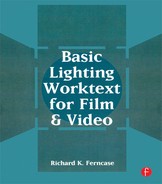0%
24Chapters
0-1Hours read
0kTotal Words
Book Description
Basic Lighting Worktext for Film and Video guides the film and video student through a series of readings, exercises and projects designed to provide the fundamentals of light science. In addition to up-to-date descriptions of equipment and tips on how to use it properly, the book provides numerous set-ups that illustrate the techniques and thoughts behind proper studio and location lighting.From this book, you will learn:
* The fundamentals of light and electricity in film
* The fine distinction of lighting for video versus lighting for film
* How to identify and filter sources such as daylight, tungsten, fluorescent, arc, HNI and industrial discharge lamps
* The use of lensed and open-faced lighting fixtures
* How to modify with barndoors, scrims, snoots, nets, cookies, and other accessories
* Variations on the basic three-point lighting setup
* The duties of each member of a lighting unit
* How to light night exteriors, day interiors, and campfires
* High-key, low-key, and modulated value lighting
* How to scout locations, plan lighting, plots, and pre-rig sets
Table of Contents
- Cover
- Half Title
- Title Page
- Copyright Page
- Dedication
- CONTENTS
- Preface and Acknowledgments
- CHAPTER ONE THE VISIBLE SPECTRUM
- CHAPTER TWO FILM AND EXPOSURE
- CHAPTER THREE USING ELECTRICITY
- CHAPTER FOUR VIDEO, THE ELECTRONIC MEDIUM
- CHAPTER FIVE CONTROLLING COLOR TEMPERATURE: LIGHT SOURCES AND FILTERS
- Introduction
- Color Temperature
- Photographic Daylight
- Tungsten Illumination
- Fluorescent Lamps
- Carbon Arc Lamps
- Enclosed Arc Lamps
- Filters
- Filtering Fluorescent Lamps
- Filtering Arc-Type Lamps
- Self-Study
- Project 5.1: Identifying Artificial Sources
- Project 5.2: Using Color-Balancing and Color-Compensating Filters
- CHAPTER SIX CONTROLLING LIGHT QUALITY: LIGHTING EQUIPMENT
- CHAPTER SEVEN MEASURING LIGHT INTENSITY
- CHAPTER EIGHT MANIPULATING LIGHT: DIRECTION AND BALANCE
- CHAPTER NINE LIGHTING CONCEPTS IN PRACTICE
- CHAPTER TEN LIGHTING IN THE STUDIO
- Introduction
- The Production Crew
- The Studio
- The Television Studio vs. The Motion Picture Soundstage
- The Cyclorama
- Project 10.1: The Limbo Effect
- Day Interiors
- Lighting Designs
- Project 10.2: High-Key Living Room—Afternoon
- Project 10.3: Bedroom Side Lighting—Early Morning
- Night Interiors
- Project 10.4: The Night Office
- Project 10.5: Living Room Cross-Key Lighting—Evening
- Night Exteriors
- Project 10.6: Moonlit Night by a Campfire
- CHAPTER ELEVEN LIGHTING ON LOCATION
- Introduction
- Location Scouting and Planning
- Day Exteriors
- Project 11.1: Lighting a Daylight Exterior
- Night Exteriors
- Project 11.2: Night Exterior—Sidewalk on a Residential Street
- Day Interiors
- Project 11.3: Balancing Sources in a Daytime Office
- Pre-Rigging
- Project 11.4: Lighting a Controlled Croup (Table)
- Lighting in the Real World
- Appendix A: Filters for Light Balancing and Color Compensating
- Appendix B: Some Additional Rosco Filters for Special Applications
- Glossary
- Bibliography
